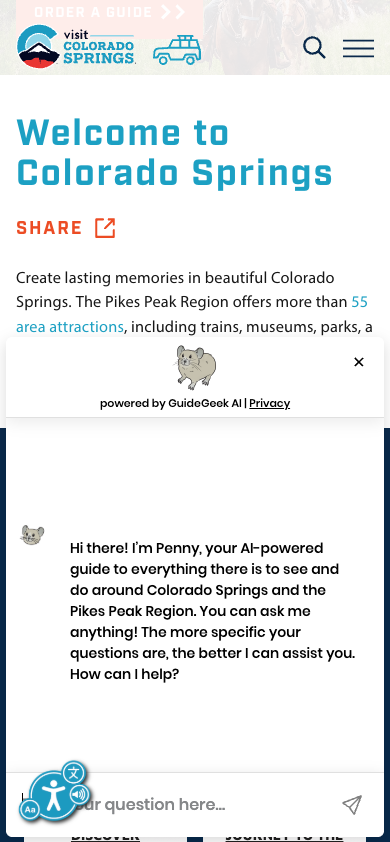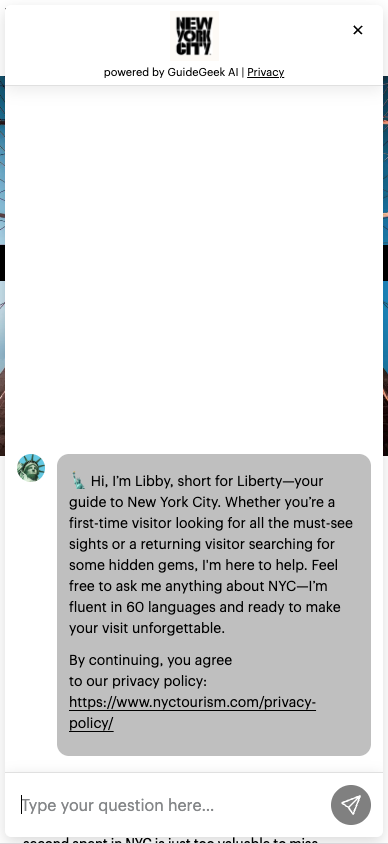
Leaders from a mix of destination organizations share how they’re adapting to AI — from redefining KPIs and experimenting with chatbots to integrating new tools into daily workflows. A new Destinations International survey captures how destinations of all sizes are measuring success in an evolving digital landscape.
Submitted on behalf of the Destinations International Marketing Committee.
In the last two years, artificial intelligence (AI) has gone from a far-off concept to a buzzy talking point to an essential part of day-to-day operations for many destination organizations. AI now touches nearly every corner of destination marketing, reshaping how travelers discover destinations and how DMOs measure success.
To get a pulse on how the industry is (and isn’t!) embracing AI, the AI & Technology Subcommittee within Destinations International’s Marketing Committee recently distributed a survey to destination professionals representing organizations of various sizes and budgets. The responses were candid, painting a picture of an industry experimenting with AI, figuring out what works and being honest about the challenges.

The Impact of AI-Powered Search on Discovery and Measurement
For many destinations, the rise of AI-powered search has been a game-changer — albeit sometimes in tough ways.
Melissa Williams, Director of Marketing at Visit Colorado Springs, described the speed and magnitude of the shift at her organization:
“We've seen AI-powered search completely upend our website traffic and performance, with key KPIs dropping in the double digits every month. We are now pulling in new ways to measure success, such as impressions, engagement, time on site, and referrals from LLMs [Large Language Models].”
At Visit Mesa, Director of Marketing Kate Yordi said the focus has shifted from raw numbers to quality of engagement:
“We’ve seen traditional organic sessions soften while the visitors who do click through are more intent-driven. That’s pushed us to judge the site less by raw traffic and more by whether it helps people engage. Our north star is usefulness: clear answers, smooth paths from ideas to plans, and momentum toward our partners.”
Key Takeaway: Website traffic patterns are shifting, and destinations are adapting by emphasizing metrics that reflect visitor engagement and intent rather than sessions and clicks.
Try This At Your DMO: Add LLM referrals, engaged sessions and post-click depth to your website reporting.

AI in External Marketing Applications
With organic search and destination discovery evolving, many destinations are leaning on Pay-per-click (PPC) and content strategy in new ways.
Williams noted that a strong PPC program has helped keep Visit Colorado Springs steady, and success isn’t defined by Clickthrough rate (CTR) alone:
“We have always invested in a very robust PPC strategy and… are adjusting our conversions to focus more on engagement rather than clicks.”
Yordi concurred — at Visit Mesa, PPC isn’t evaluated in a silo anymore:
“Paid clicks tell a smaller part of the story. We’ve shifted from buying traffic to funding momentum by using PPC to capture high-intent demand and move people from curiosity to a plan.”
For New York City Tourism + Conventions, the focus has been on adapting content for AI-driven environments. Senior Vice President of Digital + Media Carissa Parrish explained a new approach:
“One recent initiative has been piloting an ‘Article Summary’ feature on content created by our in-house team… These summaries serve a dual purpose: they improve usability for human visitors while also being optimized for Answer Engine Optimization (AEO) and Generative Engine Optimization (GEO).”
Key Takeaway: Paid search and SEO aren’t going away, but destinations are reframing how they measure performance — looking beyond clicks and experimenting with AI-optimized content formats.
Try This At Your DMO: Test structured “Article Summary” modules on high-traffic pages. Keep them short and link-rich, and track LLM impressions and referrals.

AI Chatbots & Visitor Engagement
If there’s one area where AI is already delivering visible results, it’s chatbots. Destinations are finding them useful for fast service, better accessibility, and new insights into visitor intent and interests.
Williams said the GuideGeek chatbot on Visit Colorado Springs’ website quickly found an audience:
“We are seeing a lot of success in how widely utilized the bot is without any sort of large push from us — bringing in 6k+ messages in just a few months from 3k+ users.”
At Mesa, the chatbot rollout is tied directly to visitor experiences:
“We’ll meet travelers in the moment with QR codes on signage and partner touchpoints that open the bot instantly,” Yordi explained. “To understand real impact, we’ll pair platform reporting with Tourism Economics’ Website Impact Calculator (WIC) to connect these conversations to estimated visits and local economic value.”
Parrish shared that for New York City, chatbots are also about accessibility at scale:
“The rollout has expanded our language coverage from five to 60; to date, we’ve communicated with users in 41 different languages.”
And in Puerto Rico, conversions are the focus. Dalissa Zeda, Digital Marketing Director at Discover Puerto Rico, reported:
“In July we noted positive engagement signals: a 12% increase in user registrations, a 52% increase in trips created, and an 84% increase in chat-to-trip conversions.”
Key Takeaway: Chatbots are proving their worth — not just through message volume but through engagement signals, conversions and even multilingual reach.
Try This At Your DMO: You can start small, launching a chatbot on 5-10 highly trafficked pages or key visitor touchpoints in your destination. Most critically - monitor the chats, provide feedback to your software provider and use AI to look for common visitor comments/questions.


Internal Adoption & Team Education
Behind the scenes, destinations are figuring out how to bring staff along on the AI journey.
At Visit Colorado Springs, adoption has been uneven, with some staff enthusiastic and others more resistant. To address these concerns, the team has offered a mix of internal trainings, outside workshops and webinars.
By contrast, Visit Mesa has made AI use a mandate from leadership.
“Buy-in started at the top,” Yordi said. “Our CEO set the expectation that AI is part of how we work… Each role sets at least one AI objective in its performance plan, so learning isn’t optional.”
NYC Tourism + Conventions is building capacity more organically.
“Our product development team, responsible for the two chatbots, has led the charge on stakeholder engagement by establishing a monitoring schedule, an active Slack channel, and monthly meetings to share insights,” Parrish explained.
Meanwhile, Discover Puerto Rico is still in the early stages of policy development, with adoption happening on an individual or team level while policies are being developed, according to Dalissa.
Key Takeaway: Two viable models emerged: leadership mandate and peer-led pilots. Some destinations are experimenting voluntarily, while others are embedding AI expectations into team goals from the start.
Try this at your DMO: If you haven’t already, start experimenting with generative AI. There’s more than one way to infuse AI into your organization’s DNA, so regardless of your DMO’s size or approach, pilot some low-risk uses and iterate.
Looking Ahead
When asked about the next 6–12 months, respondents agreed AI will become more embedded in daily work, even if the exact path varies.
Williams anticipates staff will be able to take on more as training expands. Yordi sees AI increasingly built into departmental objectives.
Parrish stressed the importance of setting benchmarks and monitoring programs. And Zeda acknowledged that Puerto Rico is still in the early stages of developing formal KPIs around AI adoption.
Key Takeaway: AI isn’t just a short-term experiment. Destinations expect it to become part of everyday workflows, policies, and KPIs — even if they’re still defining what that looks like.
Final Thoughts
AI is already altering how destination organizations think about success: traffic patterns are shifting, and metrics centered on engagement, conversions, and usefulness are taking center stage. Chatbots are proving their value, and internal adoption strategies range from top-down mandates to peer-led experimentation.
What ties all of this together is balance: destinations aren’t chasing AI for AI’s sake. They’re finding ways to use it thoughtfully — enhancing human work, not replacing it.
How is AI impacting your organization’s workflows and marketing strategies?
Share ideas and engage in AI-centered conversations in the Destinations International AI Community.
Submit Your Thought Leadership

Share your thought leadership with the Destinations International team! Learn how to submit a case study, blog or other piece of content to DI.



